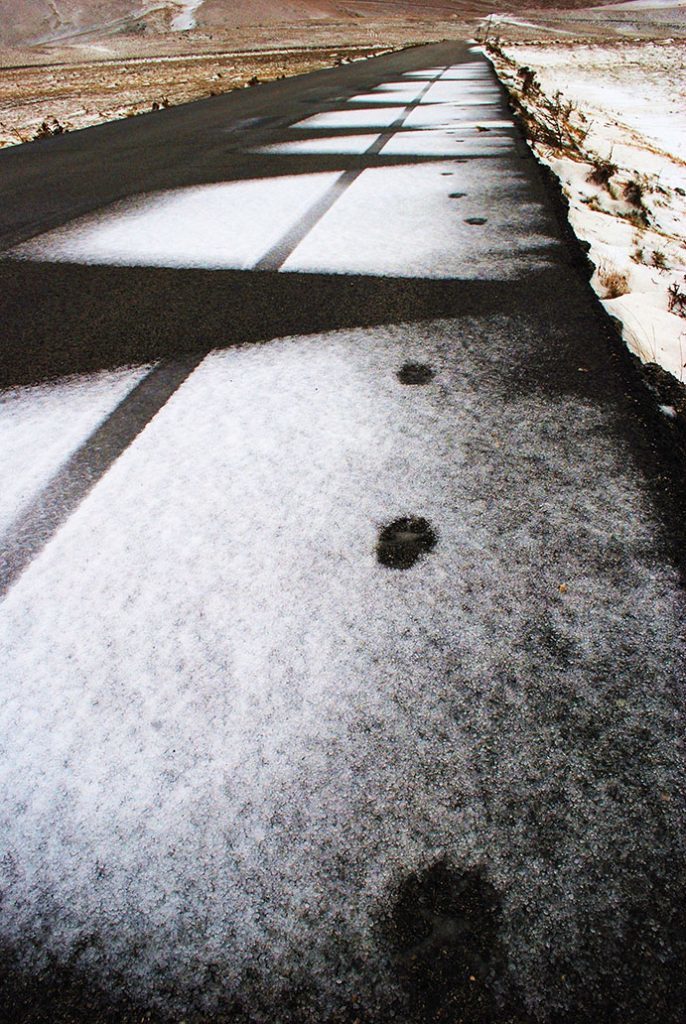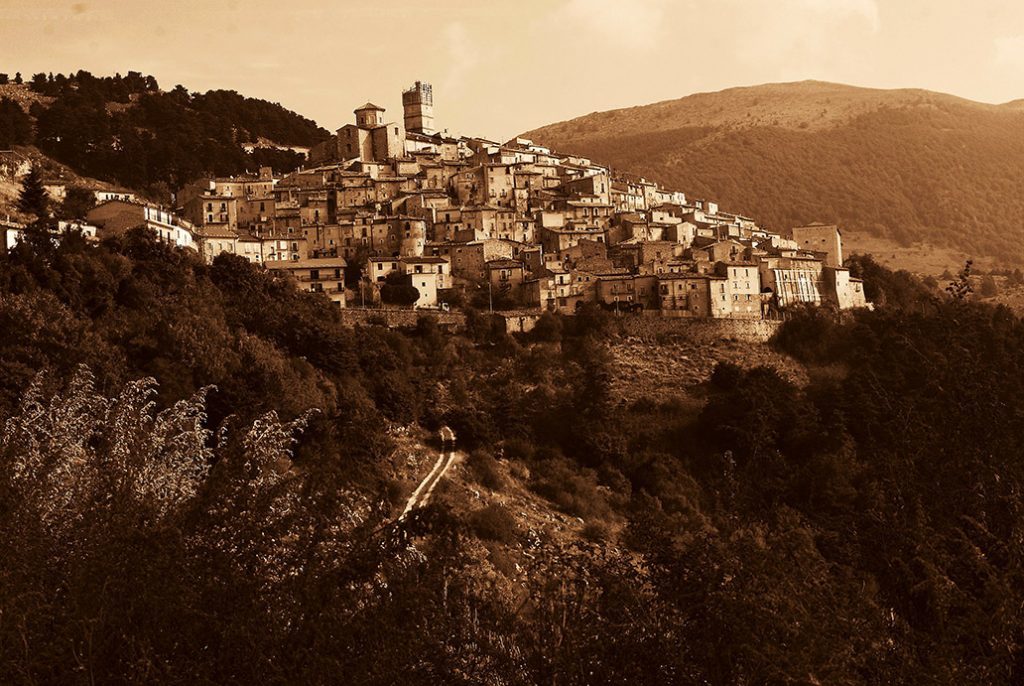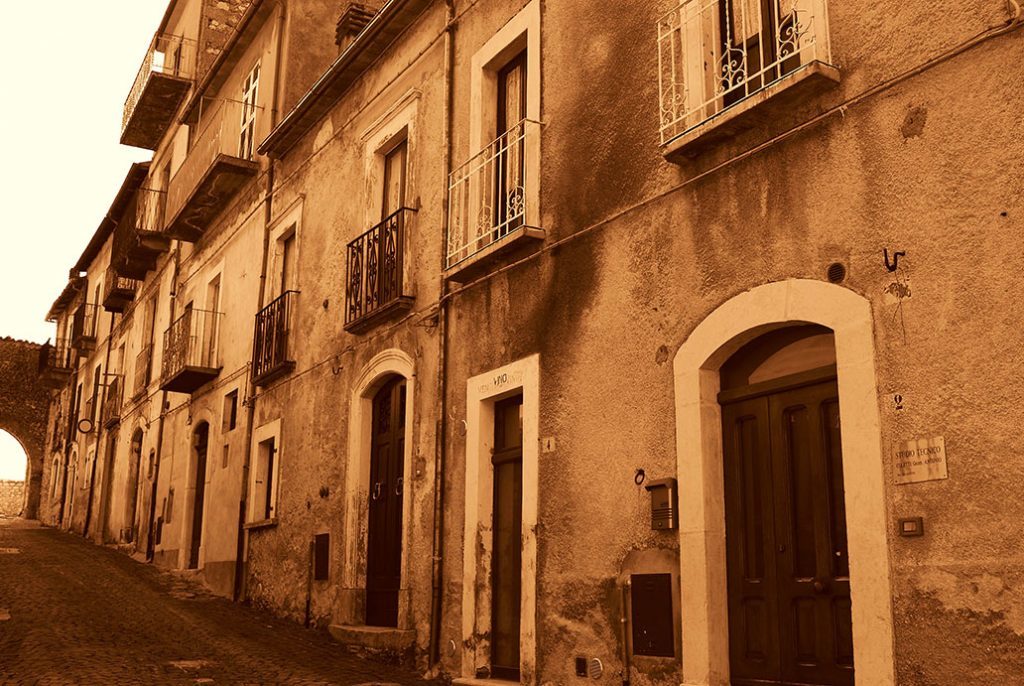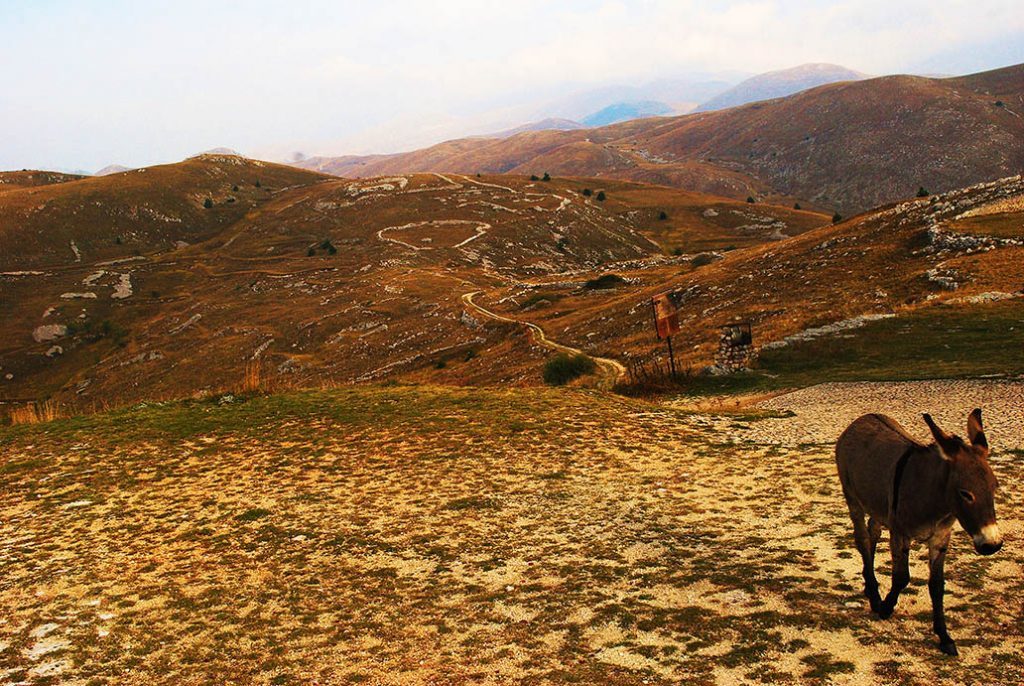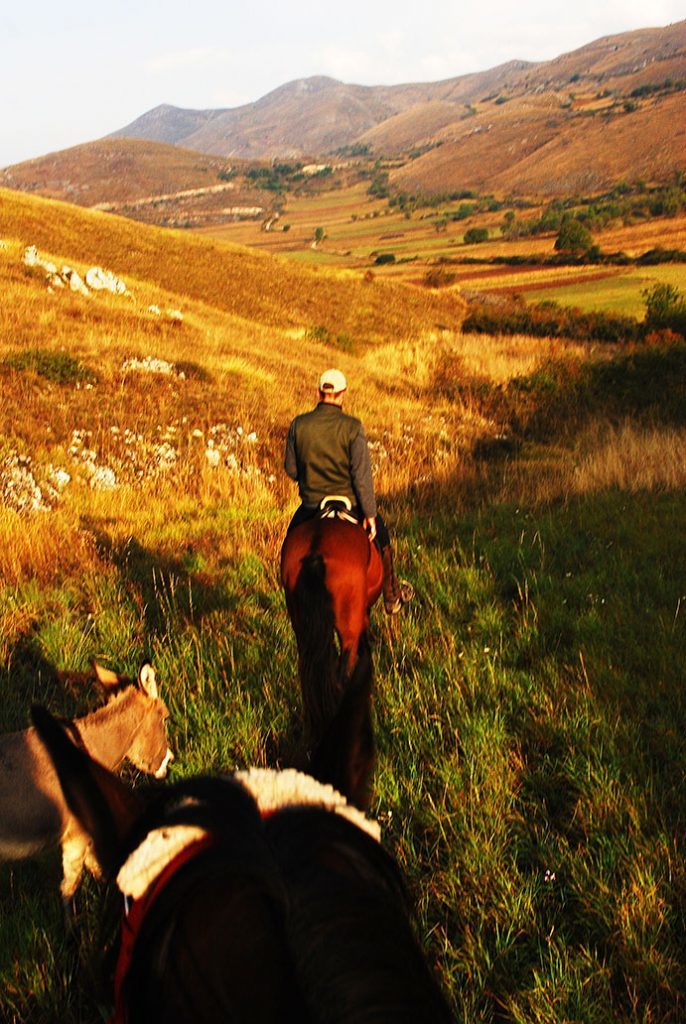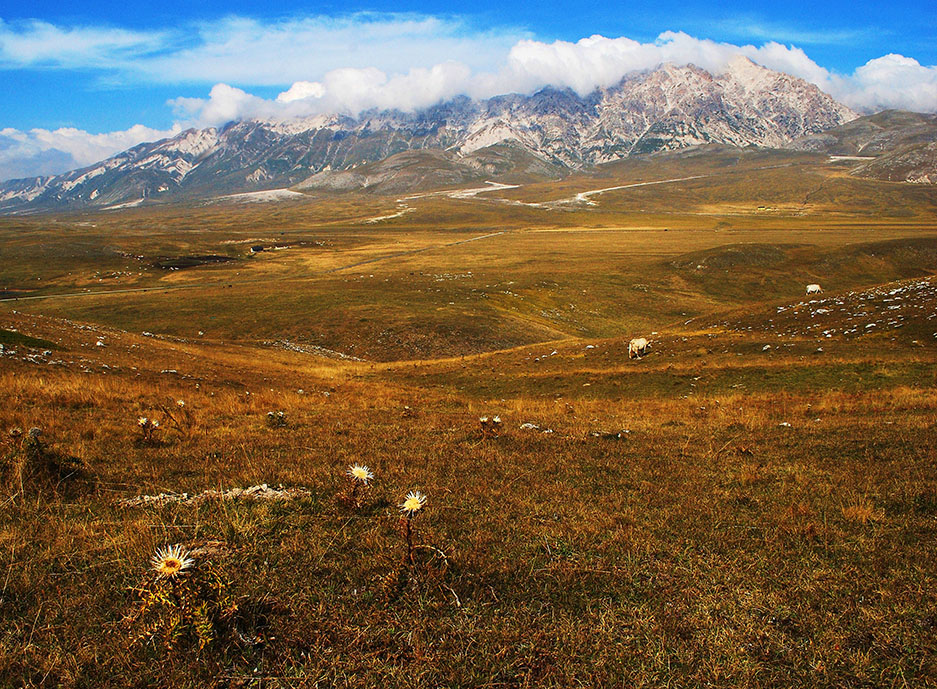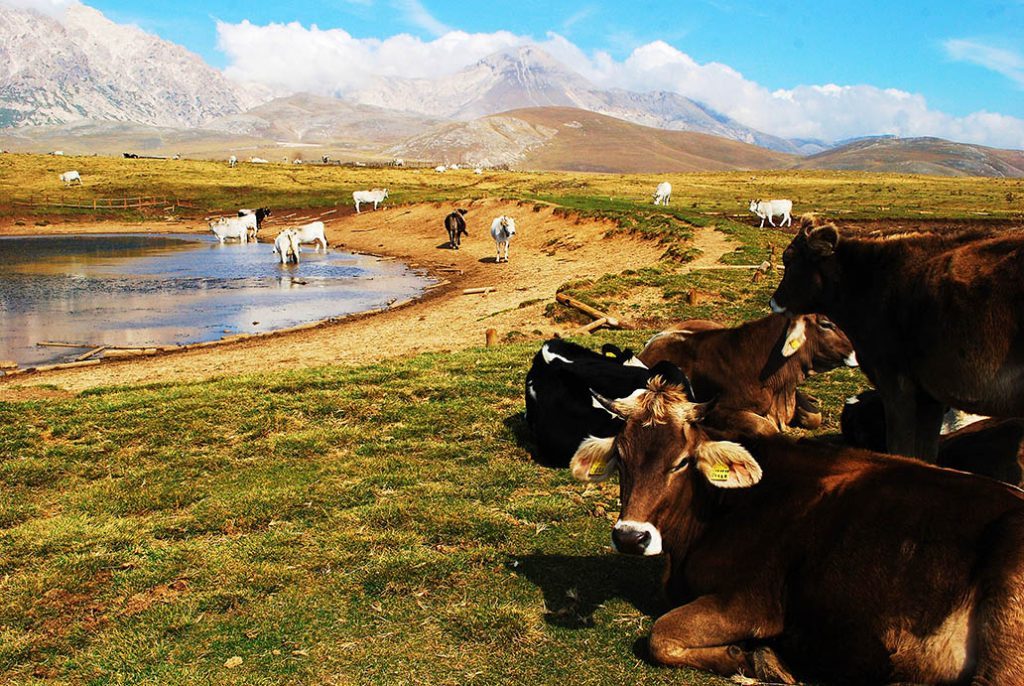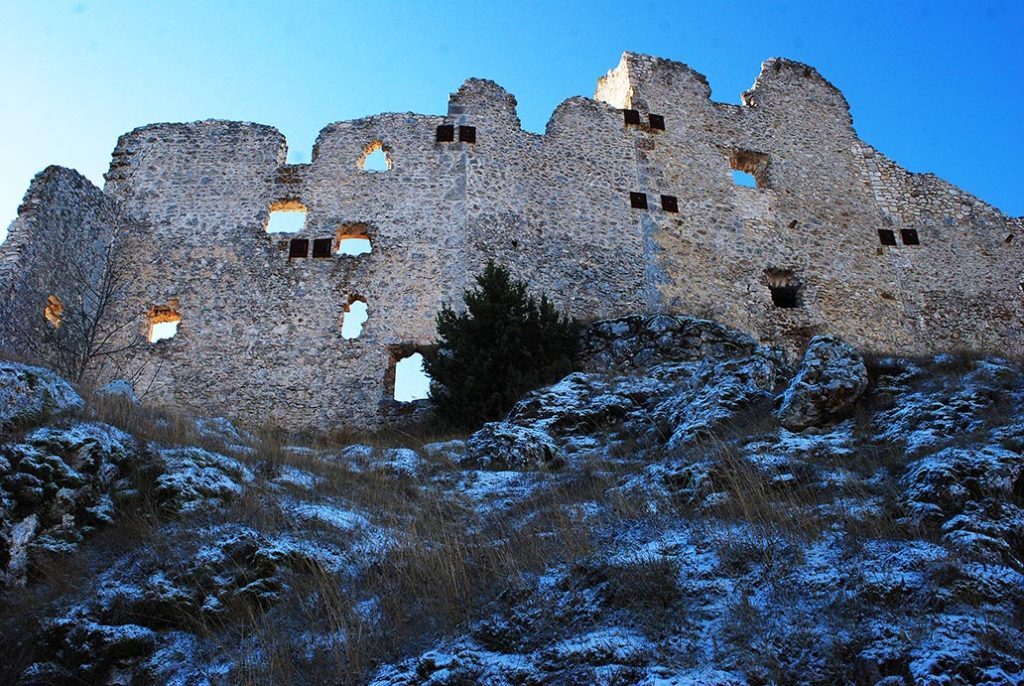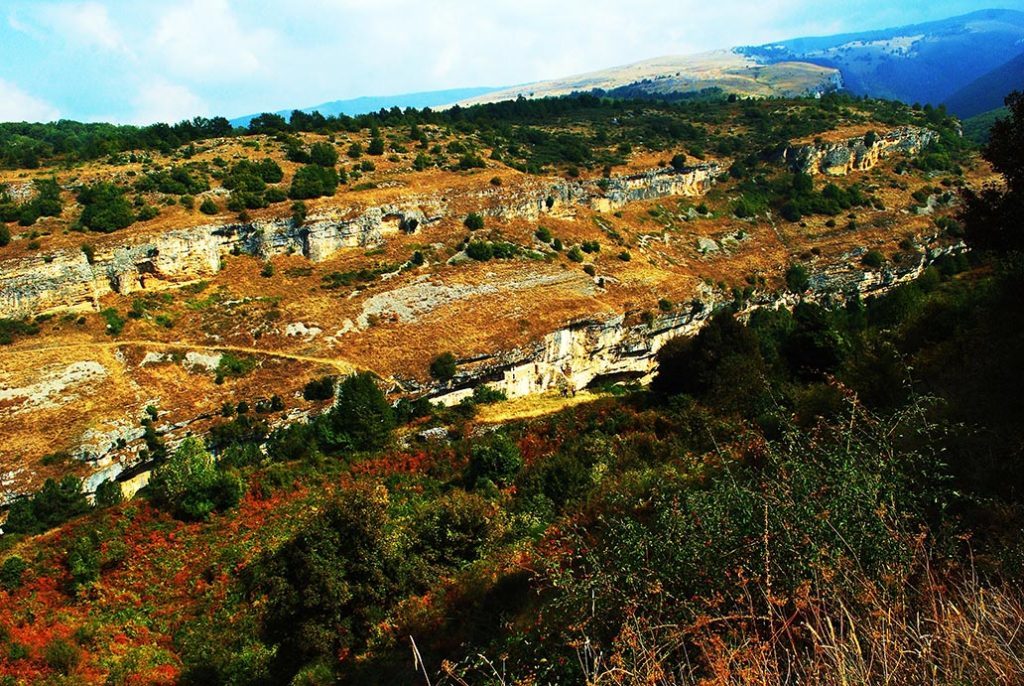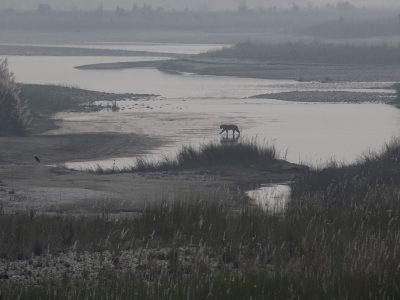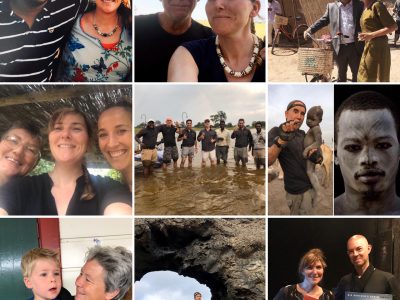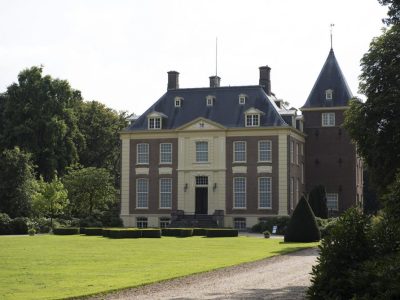The fresh mountain air of Abruzzo penetrates deep into the nostrils and the retina is on edge, looking for a trail of the brown bear, the wolf or the chamois. None of them show up, of course. This is the beating green heart of the national parks of Abruzzo. A different, robust and pure Italy where time seems to stand still.
Text & photo’s: Angelique van Os

Abruzzo, you have to be very quiet. You have to be patient for two to three hours. They don’t see much, but they smell like the best. If you’re lucky, they can loom up from nowhere on the mountainside, looking for bushes. Two weeks ago I spotted six bears in one day. Now you won’t see them. They’re moving more and more into the woods, looking for food.” Parkranger and mountain guide Paolo Iannicca talks passionately about the Marcian brown bear, the pride of Parco Nazionale d’Abruzzo, Lazio e Molise. Surrounded by robust mountain views at an altitude of 1835 metres, and looking down on the forest below, he peers through his binoculars into the surroundings. No, not successful today. The bear determines, no success is guaranteed on any safari. Then head for the mountain hut, where bruschetta is roasted on an old black stove, supplemented by fresh regional ricotta, jam, peccorino and salami. After an hour of climbing up and staring into the cold, a simple meal gives a lot of satisfaction.
From spring onwards, the ranger regularly organizes bear rides, where visitors can also spend the night in the mountain hut. Until mid-September, the bears are counted and closely monitored by Iannicca and his colleagues who together form the active nature organization Ecotur. The small town of Pescasseroli (2500 inhabitants) is the main gateway to the park, just one hundred kilometres from Rome. The oldest park in Abruzzo (1923) contains over 250 km of hiking trails and consists of 50,000 hectares of greenery. It was to become the European Yellowstone Park, with the aim of returning its former ‘inhabitants’. “Despite the fact that Abruzzo has the highest bear density in the world (!), there are only about forty specimens living in this area. This makes it the most endangered bear species on our planet,” says Paolo Iannicca sadly. “The bears and wolves are completely dependent on the local population. Fortunately, this is going in the right direction, especially since the arrival of the other nature parks. There is hope for the future.”
“The bears and wolves are completely dependent on the local population. Luckily that’s going in the right direction”.
Knocking clod
The locals indeed seem proud of their showpieces and honor the bear and the wolf with statues, fountains and information centers. And more importantly, after years of struggling, there is finally enough support for breathtaking state parks like Gran Sasso and Majella and the regional Sirente Velino. All that green and game together form the ‘throbbing calf’ of Italy.
The chance that the wolf will show up is even smaller than the bear. Even in the village of Civitella Alfedena, which has embraced the shy animal since the 70’s and which takes in sick and injured specimens in a fenced off piece of forest, there is nothing to see. After staring through the gauze for half an hour, it’s been nice. There is also no trace of the rare lynxes that cover a small habitat a bit higher up in the village. ile and three hundred bird species living in the surrounding area. The female park supervisor tells us that the shepherd’s village initially protested quite a bit against the arrival of the wolf. After all, the animal was a threat to the sheep herds. After much effort from local conservationists, more ‘sheep’ crossed the bridge, with the result that the ancient wolf now leaves its footprints far beyond the boundaries of the park. There is nothing more to discover than traces. If you look closely, you can – especially at dusk – see a fox running from the bushes, see red deer grazing or bump into wild boars. There are about sixty mammalian, forty rept
Fairy-tale film set
Whether animals or not, the fairytale and diverse landscape makes up for it. The sloping and robust mountain tops, winding narrow roads and wide vistas breathe peace and quiet. The picturesque villages with their spooky twist complement the still life perfectly. Many mountain villages, such as San Stefano di Sessanio, Calascio, Calascio della Rocca and Castel del Monte – about 35 kilometres from the provincial capital, L’Aquila – are only partly inhabited. On the one hand this has to do with the total emptying after the Second World War. Houses were shot to pieces and there was too little employment, so people were forced to leave for the city. On the other hand, a lot of damage was caused by the regular earthquakes, in which the shocks in 2009 cost the lives of almost three hundred people in L’Aquila. However, more and more modal Italians, Englishmen and Germans are buying a piece of land and refurbishing a house as a holiday home. Tourism is very important for the environment, but somehow the European interest is very limited. Tourism is picking up again in the 12th century ‘lentil village’ of San Stefano, which during the Renaissance was a mighty han-delivery and wool place by the Piccolomini – and later the Medici – family.
The slightly higher mountain town of Castel del Monte was in turmoil in 2010 because of the recordings for The American (2010), the second film by top photographer and director Anton Corbijn. The village and its surroundings formed the picturesque backdrop for the thriller, with George Clooney and the Dutch Thekla Reuten in the lead roles. The beautiful ruins of Rocca Calascio (1460m) in Abruzzo were also the ideal film set of Lady Hawke (1985) with Michelle Pfeiffer and Rutger Hauer. Even in the seventies the plateau of Campo Imperatore regularly formed a film set for various spaghetti westerns, in which the so-called Americans were simply interpreted by Italian actors.
Hop horse, hop
From San Stefano it is possible to go horseback riding with Claudio Mecoli as your guide. For a number of years now, he has owned a small herd with which he takes groups out on a daily basis. I frown my eyebrows when he walks in with two small, delicate horses. Do those narrow hooves have to brave the rugged rocky landscape? Within five minutes the anxiety turns out to be a false alarm, because despite their small feet the animals move with ease over steep paws and rough stones. They are used to it and are bursting with energy. Sagging in the saddle, reins loosely in the hand and blindly relying on the horse. It gives an appalling feeling of freedom to race through the vast fields and hills, where there is no living soul to be seen. However, Claudio is followed by his faithful companion, Budino. Whenever he feels like it, this young donkey goes along with him. Like a faithful dog, he chases his owner on his dead field, grazes a bit and then with an exuberant sprint he keeps up with his flock.
After a long climb, the view from Rocca Calascico over Gran Sasso Imperatore and Castel del Monte is breathtaking. The village forms the heart of yellow and grey mountain views that seem to flow into the horizon. The winding roads are quiet and deserted and all that beauty is just one of the many driving possibilities in the area. In the booklet The Sibyl, the Saint, and the shepherd, by Rodolfo Lorenzi, more than 839 (!) km of bridleway is described that runs through the Abruzzo national parks.
Fiery Campo Imperatore
A real Gran Sasso expert and good company is (mountain) guide, Lorenzo Baldi. The cheerful Italian, who was originally a pilot, traded city and flying engines for the small settlement of Calascio at the end of the 90s. Here he starts a cosy Bed & Breakfast and joins the outdoor organization Mountain Evolution in Abruzzo as a guide. He also works for a local tourist office, which makes him speak English very well. With his ugly appearance, slender stature and knowledge of nature, he is a beloved celebrity in the surrounding area. Everyone knows him; one phone call is enough to organize a dinner or to get an update on the weather conditions in the mountains. At the end of September the airflow is soft and pleasant on top of the sloping sandstone plateau of Campo Imperatore, which stretches over 25 km. The summit of the Corno Grande (2912m) shines in the sunshine. The summer bustle of picnicking hikers and families is over. Loose and grazing cows and horses are the only inhabitants here, as well as passing flocks of sheep and their shepherds. The great white Abruzzo dog is a specially bred breed that protects its flock from wolves and other predators. They watch over ‘their offspring’. They leave their floats to Bordercollie-like species.
In mid-December, Campo Imperatore looks very different due to very turbulent weather. Despite wind force 7 and surrounded by a white blanket of fog, it doesn’t stop Lorenzo Baldi from taking a brisk walk. “What shall I do, use my compass or my instinct? I don’t think either one of us will take us back to civilization,” he jokes. In spite of the thick fog that suddenly disappears as it arrives, the guide knows exactly where he is. The wind cries as the wolf sings his lamentation. From his toes he yells and yells in search of prey. The wet snow turns into rain. This stormy cold is distressing and refreshing at the same time. The road to a higher hotel, where a small ski area is located, is still open, but it is unwise to continue. A bit further the guide gets out of the car pointing to the ground: “Look, these are wolf tracks. But they have long since disappeared, looking for shelter. ” Hey, again not so…
Dancing leaves
The other side of the mountain area has a very different view with its winding roads and full forest with views over the Adriatic Sea and Pescara at about 35 km distance. Here too there is a storm, the birch leaves dance along the road and branches and small boulders block the road. Lorenzo Baldi is looking for adventure in a lesser-known hiking area, on the edge of Vado di Sole. The forest path is narrow and the guide disappears into the leaves up to his knees. The path winds up and down until it reaches an almost dry river after half an hour. Suddenly Baldi steps towards a rock with great steps, sinks on his knees and disappears under a thick foliage. “Ah, nice and fresh mountain water. Yes, there is a hidden fountain here, you just have to know: “Clambering over rugged boulders there is a beautiful view over lower villages on the one hand, and on the other hand the high mountainside looks down on us. Good condition is required with this many climbing. The ruins of a plane crash and a small monument of the pilot and a perished mountaineer show that this is not an easy area. “With good equipment you can climb to the top within eleven hours. It is spicy and steep, just look how it ends for some”, shouts Baldi against the wind.
Abdominal gliding
The next morning the wind seems to have died down and the first real snowflakes are swirling down. Appearances are deceiving, because during a visit to the ruins of Rocca Calascio, hell breaks loose. The immaculate view turns into a grayish-grey blizzard. We have to wait for better weather, which appears around noon. The plateau has been given a whole new look now that it is covered with a fresh layer of snow and the fog has cleared. “Here we go up. Make sure you drill your heel well into the snow and avoid slippery ice spots. The enjoyment can begin!” With a big smile Baldi strolls almost elastically up the mountain. The car parked in the valley on the side of the road changes into a dot after an hour of climbing. The peaks are getting closer and the view is getting wider. Breathtaking, what a space. When Baldi wants to climb further, to spot the Corno Grande on the other side, the weather changes rapidly into threatening clouds. The descent is a lot faster, partly because Baldi shoots down half giggling and slipping belly.
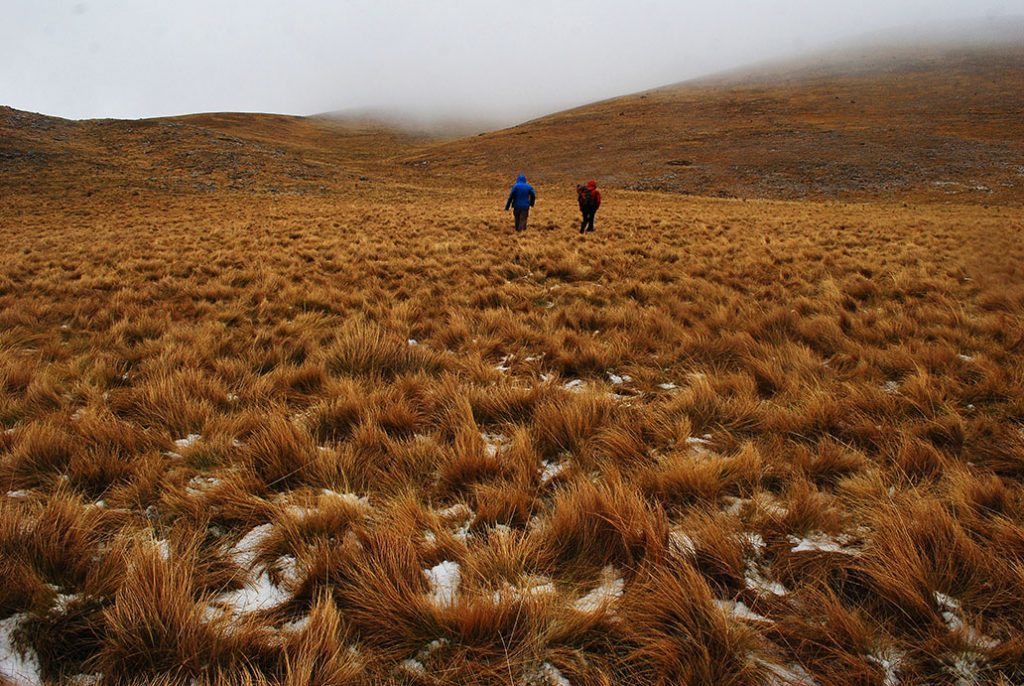
A fog blanket changes the landscape completely, but fortunately Lorenzo knows the way. 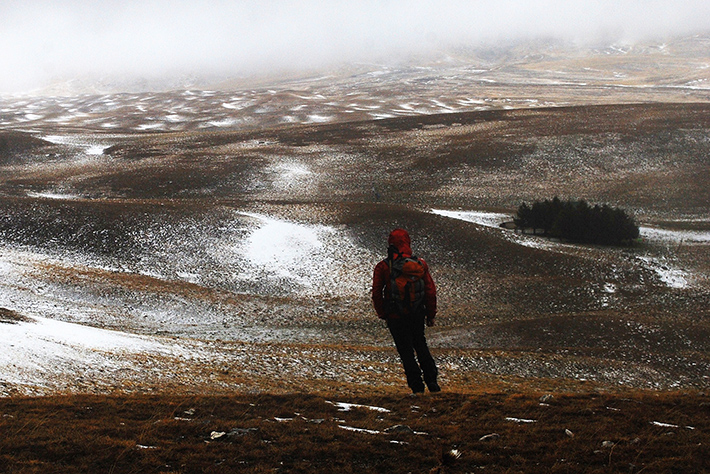
It can be harsh and grey in the early winter around Gran Sasso. 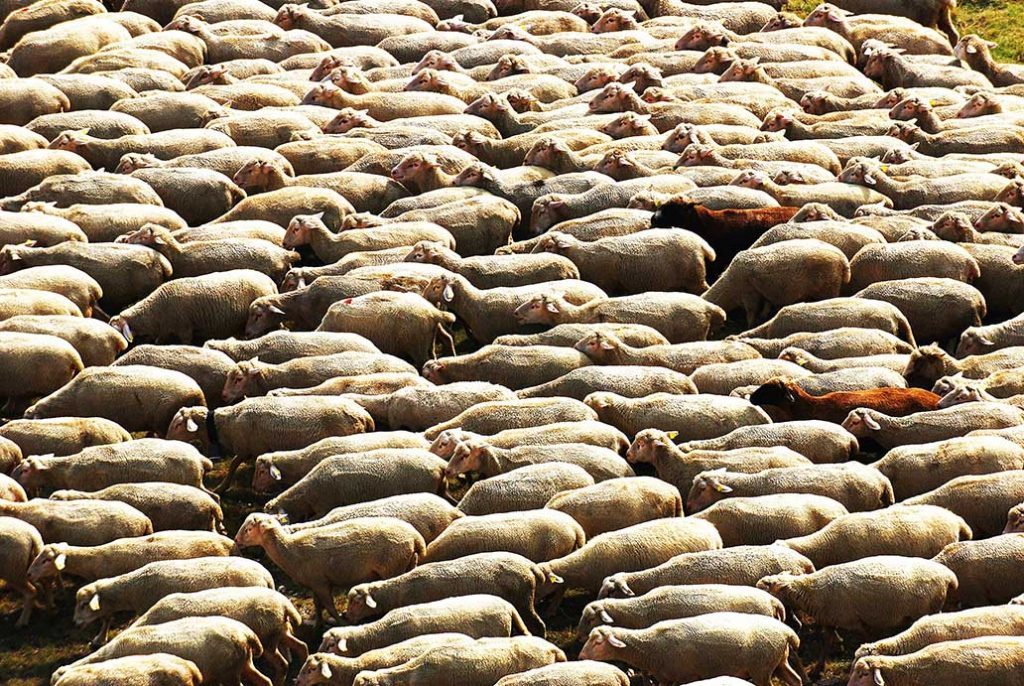
In autumn, sheep and cows dominate the landscape around Gran Sasso. 
Climbing on the first fallen snow of the year. 

The ‘other side’ of the plateau is much rougher and more dangerous to visit on your own.
Mother Mountains
Parco della Majellaarco della Majella is also a wonderful unknown hiking and climbing area, which is nicknamed the Mother Mountains because of its sacred rock and mystical atmosphere. Many hermits lived here and various hermitages and caves can be found here. There is also one of the most important cliff walls in Italy: Parete dell’ Orso, with over 250 equipped climbing routes. The park has only been in existence since 1995, and after years of struggling against the arrival of a road and ski area, the conservationists won the battle. From the village of Pianagrande guide John Forcone drives in half an hour on bumpy roads with the jeep to the high reserve, Valle del Orfento. Vertigo is the biggest enemy here, because the winding narrow paths come along high cliffs. Here too you are alone in the world, surrounded by the woody mountain inlets. The small hermitage of San Giovanni dell’Orfento is an exciting stopover. Legend has it that anyone who can slide under the very narrow rock is actually the child of their parents. If it doesn’t work out, the father has cheated on him. Sliding over the stones, about twelve metres above the ground, therefore feels like a victory.
A bit further on, after a trip through lower fields, lies another beautiful hermitage: Ermo di S. Bartolomeo in Legio. This spectacular mountain wall was carved out in the 10th century and served as a hermitage. It symbolises the ideal fusion between God and nature. The descent alone is an adventure, descending over large stones, crossing a small river, then climbing up and stopping in the sacred rock. They could undoubtedly pray and study in peace and quiet. And despite all the physical efforts, this is exactly the impression that the nature of Abruzzo leaves behind: ultimate tranquillity and purity. Or as Lorenzo Baldi would say: “A natural energy shot that deserves attention.”
Outdoor Abruzzo
Mountain Evolution
This organization offers various excursions and activities such as mountain & rock climbing, free climb above water, (snow) walks, cross-country skiing, ski tours, outdoor treks, mountain biking, kayaking and clambering in gorges and caves. I n every season you can follow activities in small groups, of one or more days. info: mountainevolution.com info: mountainevolution.comFor more information and contact with Lorenzo Baldiand the tourist office Consorzio operatori del Gran Sasso, see: gransassoitalia.it and altipianidelgransasso.com.
Bear-watching & parking excursions
Ecotur | Paolo Iannicca | Via Pave 9| ecotur.org| +39 3491491633| +390863912760
Horseback riding
Claudio Mecoli | claudio.mecoli@gmail.com | +39 3476073353
Hiking tours Majella
Majambiente, Caramanico Terme (PE), 65023, via del vivaio snc| majambiente@tin.it
www.majambiente.it c/o|+39 085 92 2343| See also: Centro Visitatori Valle dell’Orfento – CEA Paolo Barrasso.
Abruzzo practical
Flying
Flying from Eindhoven with for example Ryanair to Ciampino is the cheapest option. But not the most sustainable option. It is also possible to travel by car or train, but then you will be on the road for a few days. Rent a car from Rome; (two hours drive via the A24, direction L’Aquila Est.) to Gran Sasso and Parc Nazionale D’Abruzzo. Majella is further away. Second possibility: fly to Pescara, is much more expensive. SEE: ryanair.com. The bus also runs from the airport to Abruzzo: direct bus to Rome, metro B to Tiburtina, then regiobus to L’Aquila. Travel time: 1.5 hours. Costs: 25 euros total. Rent a car from there.
Stay Abruzzo
Despite the limited tourism, there are many beautiful small-scale hotels with excellent restaurants to be found near Gran Sasso. Some tips:
1. Monastero San Colombo
Strada Provinciale (near S. Stefano), Barisciano monasterosancolombo.com
+390862899017 This ‘heavenly place’ is located in a former monastery and even has its own church. There is also an excellent kitchen with regional dishes, such as delicious spaghetti al funghi with fresh truffle. There are monthly exhibitions and the rooms are stylishly and classy decorated.
2. B&B Acca Lascio
Via Preta Jerta, 10, Calascio| gransassoski.it| info@gransassoski.it | +08621965174 /3475572714 Tucked away between the medieval houses of the charming village of Calascio, lies the Bed & Breakfast of Lorenzo Baldi. The neat rooms are decorated in a sober Italian style. Breakfast is served in Baldi’s cosy kitchen. If you want to join us on an excursion, this guide is the right place for you. Good value for money.
3. Rifugio Rocca del Calascio
Loc. Rocca Calascio | rifugiodellarocca.it | reservation@rifugiodellarocca.it/ +393388059430 Attractive cottages in mystical style. The half ghost village lies at the foot of the famous ruin of the same name and has a beautiful view. There is also a neat dormitory for a group of 18 people and the excellent restaurant offers regional dishes and regular classical concerts.
4. Residence Il Palazzo
G.D’Annunzio, San Stefano | residenceilpalazzo.it | +3405525018 (Carla) The former horse farm, which also served as a resting place for traders during the Renaissance, has been transformed into a sober chic restaurant and pizzeria, with regional antipasti, delicious lentil soup and ravioli and ricotta. The accompanying former palazzo has eight surprisingly large and elegantly furnished antique rooms. Ask the owner for his ‘special drinks on strong water’, guaranteed for a special experience….
5. Tholos Azienda Agrituristica
C. da Collarso 105 | Roccamorice (Majella) | agriparktholos.it A special experience is an intimate dinner in a Tholos, a stone hut where no cement is applied. It used to serve as a night stay for shepherds. This restaurant and guesthouse, which uses entirely home-made natural products from its own farm, has a Tholos.
This trip has been made possible thanks to: Enit Italia, Regional Abruzzo, Ryanair and all national parks. Special thanks to Lorenzo Baldi and Franco di Martino.
More info about this beautiful region: abruzzoturismo.it


